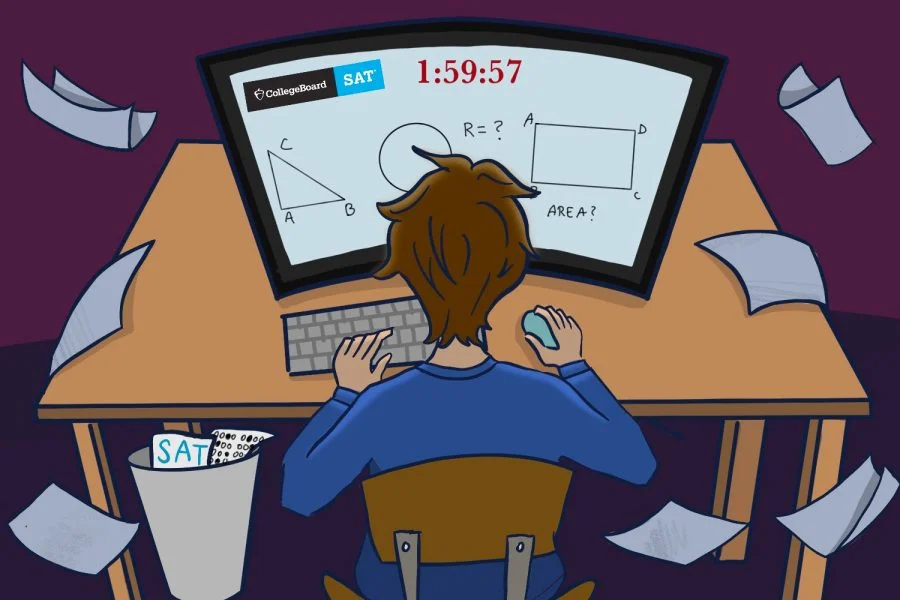Despite continued debates about the necessity of standardized testing for assessing students’ capabilities, new advancements in the Scholastic Aptitude Test (SAT) are proving standardized testing is here to stay, at least for the foreseeable future. The administration of the first round of the digital SAT and the resurgence of testing requirements for select schools are causing many students to reassess their approach to college admissions.
On March 27, 2024, Fort Hamilton High School juniors took their first digital SAT and sophomores took their first digital PSAT (Preliminary Scholastic Aptitude Test). The new digital format requires for the test to be taken on computers on Bluebook, an app where students log on to their tests with a test ticket and are able to take the test with their own personal timer.
Bluebook has features that many students find useful, such as the ability to highlight texts, cross out answers, and flag specific questions, as well as access to a desmos calculator and scrap paper specific to the math section of the exam.
The digital test itself is shorter than the paper one; the time has decreased from 3 hours and 15 minutes to 2 hours and 14 minutes in total. Instead of a separate reading and writing section and a math section with a calculator and one without, there are only two reading modules and two math modules where calculators are allowed throughout. The reading section differs from the paper version, moving from long form text, to short excerpts that change with each question.
The scoring of the exam also differs in that students may get more challenging questions in the second module depending on their performance on the first one. Easier questions bear for fewer points, while harder questions carry more.
The new format sparked controversy among test-takers at Fort Hamilton, as some long for the return of the paper SAT format, while others welcome the change.
“The digital SAT was both easier [and harder] than I expected,” said junior Amanda Chen. “The first part of each section was super easy; however, as I moved on to the second section of English and math I found myself pressed for time. Overall, I liked the new change, but I wish we could have one section each for math and English instead of separating them. I also felt that the time could be extended for the second portion because I definitely needed more time.”
Others didn’t think that the new digital SAT made a big difference for them.
“It was good! I wasn’t nervous to take it, it felt like a regular test,” said junior Zarmeen Shah.
Meanwhile, some students experienced technical difficulties with getting the computers to cooperate. Many concerns over the new digital format were over an overall lack of internet reliability and trust in technology.
“It was frustrating when we had spent a lot of time working on the computer to get it working,” said junior Ashley Lin. “Plus, I hated how everyone started at different times and there’d be a lot of extra noise, which would be especially difficult for people who were still taking the test. It’s a change that would take some getting used to, but I am hopeful to see what would happen as a result of this change.”
Despite what students felt about the new digital SAT, many of them now have no choice but to take it. Following the pandemic, many colleges established a test-optional policy, making it so that students did not have to report SAT or ACT scores. Recently, however, more colleges have reversed their test-optional policies. Colleges such as Yale, Harvard, Caltech, Dartmouth, MIT, and Brown are all schools who are now requiring students to report their test scores to be considered for admission.
“Although many colleges will remain test-optional for the 2024-2025 school year, some colleges and specialized programs will require students to submit standardized test scores,” said Ms. Ferrara, a College and Career Counselor at Fort Hamilton High School. “In order to keep their options open when applying to college, students should plan to take the SAT or ACT at least once (preferably twice), so they have scores to submit, if necessary. In most cases, students will have the opportunity to decide whether or not they want the colleges to consider their test scores as part of their application, so it is to their advantage to take the exam and see how they do.”
For schools requiring test scores, students have the option to take the ACT as well. “Most of our students start with taking the SAT, but if they would like an alternative option, they can try the ACT as well (or in place of the SAT),” Ms. Ferrara added. “Colleges will accept either exam, so it is more about the student’s personal preference. Again, it is most important for students to put themselves in the best position possible, so if that means taking more than one exam, then that might be something to consider.”
Whether a school is test optional or not, Ms. Ferrara recommends that students try to take one of these tests. Even if a student does not do as well as they had hoped, they have the option of not submitting the score if the schools to which they are applying are test optional.
“Sometimes submitting SAT/ACT scores can be a great way to ‘boost’ your application and give the colleges more insight into your abilities and potential,” Ms. Ferrara said. “In order to prepare for the exam, familiarize yourself with the different sections of the test and take some practice exams to see what kind of questions you can expect to encounter.”
Ms. Ferrara wanted to offer nervous students a word of encouragement. “The SAT/ACT is only one component of the college application,” she said. “Colleges will consider your grades, extracurricular and community service activities, college essays, [and] letters of recommendation as well, so trust in your accomplishments, and try to stay positive throughout the process.”



























